Estimating Gully Erosion Induced by Heavy Rainfall Events Using Stereoscopic Imagery and UAV LiDAR
Abstract
Highlights
- We developed a large-scale erosion estimation method that fuses data from Chinese Gaofen-series high-resolution satellites and UAVs.
- Analyze and discuss the far-reaching impacts of anthropogenic and natural factors on soil conservation across the Loess Plateau.
- Using multi-source high-resolution remote sensing data, we quantitatively assessed the impact of heavy precipitation on erosion and established a large-scale, generalizable methodology.
- Using multi-source high-resolution datasets, we quantitatively assessed how natural processes and human activities influence erosion trends.
- We developed a systematic, high-precision erosion-rate analysis method that integrates China’s Gaofen-series satellites with UAV observations, is scalable to large areas, and enables a systematic assessment of how precipitation events affect erosion rates on the Loess Plateau.
- We elucidated the causes of soil erosion under the combined effects of human and natural factors and proposed methodological guidelines.
Abstract
1. Introduction
2. Materials and Methods
2.1. Materials
2.1.1. Study Area
2.1.2. Datasets
2.2. Methods
2.2.1. Overall Technical Framework
2.2.2. DSM Calibration and Validation Based on UAV
2.2.3. Analysis of Changes in Gully Erosion Depth
2.2.4. Identification of Gully Erosion Using Optical Remote Sensing Imagery
2.2.5. Accuracy Evaluation Metrics
3. Results
3.1. Accuracy Assessment and Correction of Parameters
3.2. Dynamic Variation of Gully Erosion Depth
3.3. Drivers of Topographic Variations
4. Discussion
4.1. Potential and Uncertainty for Estimating Gully Erosion from Multi-Source Remote Sensing Imagery
4.2. Erosion Drivers and Human Impacts
4.3. Limitation and Future Works
4.4. Methodological Extensions to Other Fields
5. Conclusions
Author Contributions
Funding
Data Availability Statement
Conflicts of Interest
Abbreviations
| DSM | Digital surface model |
| RBF | Radial Basis Function |
| UAV | Unmanned aerial vehicle |
| SAM | Segment Anything Model |
Appendix A
| Rainstorm Statistics—Cumulative Precipitation Value (Unit: mm) | |||||||
|---|---|---|---|---|---|---|---|
| Site Name | Site Code | Site Type | Precipitation | Precipitation Level | Statistical Time Period | Statistical Basis | Occurrence Time |
| Huajialing | 52996 | Basic Station | 39.8 | Heavy Rain | Accumulated value from 20:00 to 08:00 | Rainfall in the last 12 h: 30.0 to 69.9 mm | 9 July 2015 |
| Huajialing | 52996 | Basic Station | 31.8 | Heavy Rain | Accumulated value from 08:00 to 20:00 | Rainfall in the last 12 h: 30.0 to 69.9 mm | 14 July 2015 |
| Huajialing | 52996 | Basic Station | 44.6 | Heavy Rain | Accumulated value from 20:00 to 08:00 | Rainfall in the last 12 h: 30.0 to 69.9 mm | 23 June 2016 |
| Huajialing | 52996 | Basic Station | 40 | Heavy Rain | Accumulated value from 20:00 to 08:00 | Rainfall in the last 12 h: 30.0 to 69.9 mm | 27 July 2017 |
| Huajialing | 52996 | Basic Station | 46.7 | Heavy Rain | Accumulated value from 08:00 to 20:00 | Rainfall in the last 12 h: 30.0 to 69.9 mm | 6 August 2017 |
| Huajialing | 52996 | Basic Station | 46.3 | Heavy Rain | Accumulated value from 20:00 to 08:00 | Rainfall in the last 12 h: 30.0 to 69.9 mm | 2 July 2018 |
| Huajialing | 52996 | Basic Station | 47.4 | Heavy Rain | Accumulated value from 08:00 to 20:00 | Rainfall in the last 12 h: 30.0 to 69.9 mm | 2 August 2019 |
| Huajialing | 52996 | Basic Station | 61 | Heavy Rain | Accumulated value from 20:00 to 08:00 | Rainfall in the last 12 h: 30.0 to 69.9 mm | 26 June 2020 |
| Huajialing | 52996 | Basic Station | 38.8 | Heavy Rain | Accumulated value from 20:00 to 08:00 | Rainfall in the last 12 h: 30.0 to 69.9 mm | 18 July 2020 |
| Huajialing | 52996 | Basic Station | 31.5 | Heavy Rain | Accumulated value from 08:00 to 20:00 | Rainfall in the last 12 h: 30.0 to 69.9 mm | 18 August 2022 |
| Tongwei | 53908 | General Station | 37.8 | Heavy Rain | Accumulated value from 08:00 to 20:00 | Rainfall in the last 12 h: 30.0 to 69.9 mm | 15 July 2022 |
| Tongwei | 53908 | General Station | 113.3 | Severe Rain | Accumulated value from 20:00 to 20:00 | Rainfall in the last 24 h: 100.0 to 249.9 mm | 23 July 2024 |
| Zhuanglang | 53917 | General Station | 32.8 | Heavy Rain | Accumulated value from 20:00 to 08:00 | Rainfall in the last 12 h: 30.0 to 69.9 mm | 22 June 2022 |
| Zhuanglang | 53917 | General Station | 32.1 | Heavy Rain | Accumulated value from 08:00 to 20:00 | Rainfall in the last 12 h: 30.0 to 69.9 mm | 15 July 2022 |
| Gan’gu | 57001 | General Station | 71.9 | Heavy Rain | Accumulated value from 20:00 to 20:00 | Rainfall in the last 24 h: 50.0 to 99.9 mm | 15 July 2021 |
| Qin’an | 57002 | General Station | 74 | Heavy Rain | Accumulated value from 20:00 to 20:00 | Rainfall in the last 24 h: 50.0 to 99.9 mm | 15 July 2021 |
| Qin’an | 57002 | General Station | 33.9 | Heavy Rain | Accumulated value from 20:00 to 08:00 | Rainfall in the last 12 h: 30.0 to 69.9 mm | 24 April 2022 |
| Qin’an | 57002 | General Station | 40.6 | Heavy Rain | Accumulated value from 08:00 to 20:00 | Rainfall in the last 12 h: 30.0 to 69.9 mm | 11 July 2022 |
| Wushan | 57004 | General Station | 39.4 | Heavy Rain | Accumulated value from 20:00 to 08:00 | Rainfall in the last 12 h: 30.0 to 69.9 mm | 24 April 2022 |
| Tianshui | 57006 | General Station | 71.5 | Heavy Rain | Accumulated value from 20:00 to 20:00 | Rainfall in the last 24 h: 50.0 to 99.9 mm | 15 July 2021 |
| Tianshui | 57006 | General Station | 43.4 | Heavy Rain | Accumulated value from 20:00 to 08:00 | Rainfall in the last 12 h: 30.0 to 69.9 mm | 24 April 2022 |
| Tianshui | 57006 | General Station | 41.3 | Heavy Rain | Accumulated value from 08:00 to 20:00 | Rainfall in the last 12 h: 30.0 to 69.9 mm | 22 June 2022 |
| Maiji | 57014 | Basic Station | 57.1 | Heavy Rain | Accumulated value from 08:00 to 20:00 | Rainfall in the last 12 h: 30.0 to 69.9 mm | 18 May 2017 |
| Maiji | 57014 | Basic Station | 57 | Heavy Rain | Accumulated value from 20:00 to 08:00 | Rainfall in the last 12 h: 30.0 to 69.9 mm | 7 August 2017 |
| Maiji | 57014 | Basic Station | 59.8 | Heavy Rain | Accumulated value from 08:00 to 20:00 | Rainfall in the last 12 h: 30.0 to 69.9 mm | 2 August 2019 |
| Maiji | 57014 | Basic Station | 57.8 | Heavy Rain | Accumulated value from 20:00 to 08:00 | Rainfall in the last 12 h: 30.0 to 69.9 mm | 20 August 2019 |
| Maiji | 57014 | Basic Station | 38.7 | Heavy Rain | Accumulated value from 20:00 to 08:00 | Rainfall in the last 12 h: 30.0 to 69.9 mm | 7 May 2020 |
| Maiji | 57014 | Basic Station | 53.7 | Heavy Rain | Accumulated value from 20:00 to 08:00 | Rainfall in the last 12 h: 30.0 to 69.9 mm | 25 July 2020 |
| Maiji | 57014 | Basic Station | 31.4 | Heavy Rain | Accumulated value from 20:00 to 08:00 | Rainfall in the last 12 h: 30.0 to 69.9 mm | 16 August 2020 |
| Maiji | 57014 | Basic Station | 38.8 | Heavy Rain | Accumulated value from 20:00 to 08:00 | Rainfall in the last 12 h: 30.0 to 69.9 mm | 17 August 2020 |
| Maiji | 57014 | Basic Station | 43.8 | Heavy Rain | Accumulated value from 20:00 to 08:00 | Rainfall in the last 12 h: 30.0 to 69.9 mm | 24 April 2022 |
| Maiji | 57014 | Basic Station | 32.6 | Heavy Rain | Accumulated value from 20:00 to 08:00 | Rainfall in the last 12 h: 30.0 to 69.9 mm | 14 July 2022 |
| Maiji | 57014 | Basic Station | 47.4 | Heavy Rain | Accumulated value from 20:00 to 08:00 | Rainfall in the last 12 h: 30.0 to 69.9 mm | 27 July 2022 |
| According to the Precipitation Classification Standard (GB/T 28592–2012) [78], issued and implemented by the China Meteorological Administration on 1 August 2012: Precipitation of less than 0.1 mm within 24 h is classified as trace precipitation (scattered drizzle). Precipitation of 0.1–4.9 mm within 12 h or 0.1–9.9 mm within 24 h is classified as light rain. Precipitation of 5.0–14.9 mm within 12 h or 10.0–24.9 mm within 24 h is classified as moderate rain. Precipitation of 15.0–29.9 mm within 12 h or 25.0–49.9 mm within 24 h is classified as heavy rain. Precipitation of 30.0–69.9 mm within 12 h or 50.0–99.9 mm within 24 h is classified as rainstorm. Precipitation of 70.0–139.9 mm within 12 h or 100.0–249.9 mm within 24 h is classified as severe rainstorm. Precipitation of ≥140.0 mm within 12 h or ≥250.0 mm within 24 h is classified as extraordinary rainstorm. In this study, items 5, 6, and 7 are used to count the number of rainstorm events and record their specific occurrence times. | |||||||
| Category | Cumulative Precipitation (mm) | |||||
|---|---|---|---|---|---|---|
| Year | 2019 | 2020 | 2021 | 2022 | 2023 | 2024 |
| Qin’an County | 488.3 | 589 | 432.4 | 313.2 | 253.5 | 297.4 |
| Tongwei County | 475.7 | 544.5 | 423.3 | 270.7 | 197.8 | 348.5 |
References
- Xu, M.; Li, Q.; Wilson, G. Degradation of soil physicochemical quality by ephemeral gully erosion on sloping cropland of the hilly Loess Plateau, China. Soil Tillage Res. 2016, 155, 9–18. [Google Scholar] [CrossRef]
- Zhang, X.; Zhang, S.; Meng, X.; Zhang, G.; Zang, D.; Han, Y.; Ai, H.; Liu, H. Remote sensing image segmentation of gully erosion in a typical black soil area in Northeast China based on improved DeepLabV3+ model. Ecol. Inform. 2024, 84, 102929. [Google Scholar] [CrossRef]
- Saha, A.; Pal, S.C.; Chowdhuri, I.; Islam, A.R.M.T.; Roy, P.; Chakrabortty, R. Land degradation risk dynamics assessment in red and lateritic zones of eastern plateau, India: A combine approach of K-fold CV, data mining and field validation. Ecol. Inform. 2022, 69, 101653. [Google Scholar] [CrossRef]
- Majhi, A.; Bhattacharjee, P.; Harris, A.; Evans, M.; Shuttleworth, E. Gully erosion is a serious obstacle in India’s land degradation neutrality mission. Sci. Rep. 2025, 15, 6384. [Google Scholar] [CrossRef] [PubMed]
- Samuel, S.; Dosio, A.; Mphale, K.; Faka, D.N.; Wiston, M. Comparison of multi-model ensembles of global and regional climate model projections for daily characteristics of precipitation over four major river basins in southern Africa. Part II: Future changes under 1.5 °C, 2.0 °C and 3.0 °C warming levels. Atmos. Res. 2023, 293, 106921. [Google Scholar] [CrossRef]
- Kendon, E.J.; Fischer, E.M.; Short, C.J. Variability conceals emerging trend in 100yr projections of UK local hourly rainfall extremes. Nat. Commun. 2023, 14, 1133. [Google Scholar] [CrossRef]
- Mulligan, M. Modelling the geomorphological impact of climatic variability and extreme events in a semi-arid environment. Geomorphology 1998, 24, 59–78. [Google Scholar] [CrossRef]
- Biddoccu, M.; Ferraris, S.; Opsi, F.; Cavallo, E. Long-term monitoring of soil management effects on runoff and soil erosion in sloping vineyards in Alto Monferrato (North–West Italy). Soil Tillage Res. 2016, 155, 176–189. [Google Scholar] [CrossRef]
- Wang, S.; Yan, Y.; Fu, Z.; Chen, H. Rainfall-runoff characteristics and their threshold behaviors on a karst hillslope in a peak-cluster depression region. J. Hydrol. 2022, 605, 127370. [Google Scholar] [CrossRef]
- Poesen, J.; Nachtergaele, J.; Verstraeten, G.; Valentin, C. Gully erosion and environmental change: Importance and research needs. Catena 2003, 50, 91–133. [Google Scholar] [CrossRef]
- Moeyersons, J.; Makanzu Imwangana, F.; Dewitte, O. Site-and rainfall-specific runoff coefficients and critical rainfall for mega-gully development in Kinshasa (DR Congo). Nat. Hazards 2015, 79, 203–233. [Google Scholar] [CrossRef]
- Guo, M.; Yang, B.; Wang, W.; Chen, Z.; Wang, W.; Zhao, M.; Kang, H. Distribution, morphology and influencing factors of rills under extreme rainfall conditions in main land uses on the Loess Plateau of China. Geomorphology 2019, 345, 106847. [Google Scholar] [CrossRef]
- Chen, H.; Zhang, X.; Abla, M.; Lü, D.; Yan, R.; Ren, Q.; Ren, Z.; Yang, Y.; Zhao, W.; Lin, P.; et al. Effects of vegetation and rainfall types on surface runoff and soil erosion on steep slopes on the Loess Plateau, China. Catena 2018, 170, 141–149. [Google Scholar] [CrossRef]
- Zhang, S.; Zhang, K. Assessing the impact of extreme rainfall and slope surface conditions on runoff and erosion based on a big database in Southwest China’s karst region. J. Hydrol. 2025, 659, 133273. [Google Scholar] [CrossRef]
- Vanmaercke, M.; Panagos, P.; Vanwalleghem, T.; Hayas, A.; Foerster, S.; Borrelli, P.; Rossi, M.; Torri, D.; Casali, J.; Borselli, L.; et al. Measuring, modelling and managing gully erosion at large scales: A state of the art. Earth-Sci. Rev. 2021, 218, 103637. [Google Scholar] [CrossRef]
- Seutloali, K.E.; Dube, T.; Mutanga, O. Assessing and mapping the severity of soil erosion using the 30-m Landsat multispectral satellite data in the former South African homelands of Transkei. Phys. Chem. Earth Parts A/B/C 2017, 100, 296–304. [Google Scholar] [CrossRef]
- Daggupati, P.; Sheshukov, A.Y.; Douglas-Mankin, K.R. Evaluating ephemeral gullies with a process-based topographic index model. Catena 2014, 113, 177–186. [Google Scholar] [CrossRef]
- Yang, X.; Na, J.; Tang, G.; Wang, T.; Zhu, A. Bank gully extraction from DEMs utilizing the geomorphologic features of a loess hilly area in China. Front. Earth Sci. 2019, 13, 151–168. [Google Scholar] [CrossRef]
- Arabameri, A.; Pradhan, B.; Rezaei, K. Gully erosion zonation mapping using integrated geographically weighted regression with certainty factor and random forest models in GIS. J. Environ. Manag. 2019, 232, 928–942. [Google Scholar] [CrossRef]
- Karami, A.; Khoorani, A.; Noohegar, A.; Shamsi, S.R.F.; Moosavi, V. Gully erosion mapping using object-based and pixel-based image classification methods. Environ. Eng. Geosci. 2015, 21, 101–110. [Google Scholar] [CrossRef]
- Phinzi, K.; Holb, I.; Szabó, S. Mapping permanent gullies in an agricultural area using satellite images: Efficacy of machine learning algorithms. Agronomy 2021, 11, 333. [Google Scholar] [CrossRef]
- Golosov, V.; Yermolaev, O.; Rysin, I.; Vanmaercke, M.; Medvedeva, R.; Zaytseva, M. Mapping and spatial-temporal assessment of gully density in the Middle Volga region, Russia. Earth Surf. Process. Landf. 2018, 43, 2818–2834. [Google Scholar] [CrossRef]
- Dong, F.; Jin, J.; Li, L.; Li, H.; Zhang, Y. A Multi-Scale Content-Structure Feature Extraction Network Applied to Gully Extraction. Remote Sens. 2024, 16, 3562. [Google Scholar] [CrossRef]
- Padarian, J.; Minasny, B.; McBratney, A.B. Using deep learning for digital soil mapping. Soil 2019, 5, 79–89. [Google Scholar] [CrossRef]
- Han, Q.; Yin, Q.; Zheng, X.; Chen, Z. Remote sensing image building detection method based on Mask R-CNN. Complex Intell. Syst. 2022, 8, 1847–1855. [Google Scholar] [CrossRef]
- Duan, Y.; Song, C.; Zhang, Y.; Cheng, P.; Mei, S. STMSF: Swin Transformer with Multi-Scale Fusion for Remote Sensing Scene Classification. Remote Sens. 2025, 17, 668. [Google Scholar] [CrossRef]
- Wu, Q.; Feng, D.; Cao, C.; Zeng, X.; Feng, Z.; Wu, J.; Huang, Z. Improved mask R-CNN for aircraft detection in remote sensing images. Sensors 2021, 21, 2618. [Google Scholar] [CrossRef] [PubMed]
- Tang, X.; Li, M.; Ma, J.; Zhang, X.; Liu, F.; Jiao, L. EMTCAL: Efficient multiscale transformer and cross-level attention learning for remote sensing scene classification. IEEE Trans. Geosci. Remote Sens. 2022, 60, 5626915. [Google Scholar] [CrossRef]
- Mohammed, E.A.; Lakizadeh, A. Benchmarking Vision Transformers for Satellite Image Classification based on Data Augmentation Techniques. Int. J. Adv. Soft Comput. Its Appl. 2025, 17, 98–144. [Google Scholar] [CrossRef]
- Helber, P.; Bischke, B.; Dengel, A.; Borth, D. Eurosat: A novel dataset and deep learning benchmark for land use and land cover classification. IEEE J. Sel. Top. Appl. Earth Obs. Remote Sens. 2019, 12, 2217–2226. [Google Scholar] [CrossRef]
- Kirillov, A.; Mintun, E.; Ravi, N.; Mao, H.; Rolland, C.; Gustafson, L.; Xiao, T.; Whitehead, S.; Berg, A.C.; Lo, W.-Y.; et al. Segment anything. In Proceedings of the IEEE/CVF International Conference on Computer Vision, Paris, France, 1–6 October 2023; pp. 4015–4026. [Google Scholar]
- Liang, W.; Bai, D.; Wang, F.; Fu, B.; Yan, J.; Wang, S.; Yang, Y.; Long, D.; Feng, M. Quantifying the impacts of climate change and ecological restoration on streamflow changes based on a Budyko hydrological model in China’s Loess Plateau. Water Resour. Res. 2015, 51, 6500–6519. [Google Scholar] [CrossRef]
- Chen, Y.; Jiao, J.; Yan, X.; Li, J.; Vanmaercke, M.; Wang, N. Response of gully morphology and density to the spatial and rainy-season monthly variation of rainfall at the regional scale of the Chinese Loess Plateau. Catena 2024, 236, 107773. [Google Scholar] [CrossRef]
- Xu, Y.; Luo, L.; Guo, W.; Jin, Z.; Tian, P.; Wang, W. Revegetation changes main erosion type on the gully–slope on the Chinese Loess Plateau under extreme rainfall: Reducing gully erosion and promoting shallow landslides. Water Resour. Res. 2024, 60, e2023WR036307. [Google Scholar] [CrossRef]
- De Rose, R.C. Slope control on the frequency distribution of shallow landslides and associated soil properties, North Island, New Zealand. Earth Surf. Process. Landf. 2013, 38, 356–371. [Google Scholar] [CrossRef]
- von Ruette, J.; Lehmann, P.; Or, D. Effects of rainfall spatial variability and intermittency on shallow landslide triggering patterns at a catchment scale. Water Resour. Res. 2014, 50, 7780–7799. [Google Scholar] [CrossRef]
- Jin, Z.; Peng, J.; Zhuang, J.; Feng, L.; Huo, A.; Mu, X.; Wang, W. Gully erosion and expansion mechanisms in loess tablelands and the scientific basis of gully consolidation and tableland protection. Sci. China Earth Sci. 2023, 66, 821–839. [Google Scholar] [CrossRef]
- Wang, Z.-J.; Jiao, J.-Y.; Rayburg, S.; Wang, Q.-L.; Su, Y. Soil erosion resistance of “Grain for Green” vegetation types under extreme rainfall conditions on the Loess Plateau, China. Catena 2016, 141, 109–116. [Google Scholar] [CrossRef]
- Govers, G.; Giménez, R.; Van Oost, K. Rill erosion: Exploring the relationship between experiments, modelling and field observations. Earth-Sci. Rev. 2007, 84, 87–102. [Google Scholar] [CrossRef]
- Lei, T.; Nearing, M.A.; Haghighi, K.; Bralts, V.F. Rill erosion and morphological evolution: A simulation model. Water Resour. Res. 1998, 34, 3157–3168. [Google Scholar] [CrossRef]
- Zhang, S.; Zhao, G.; Mu, X.; Tian, P.; Gao, P.; Sun, W. Changes in streamflow regimes and their responses to different soil and water conservation measures in the Loess Plateau watersheds, China. Hydrol. Process. 2021, 35, e14401. [Google Scholar] [CrossRef]
- Owada, H.; Ohmori, H.; Matsumoto, J. Seasonal Changes in Wind Systems Relating to Precipitation during the Rainy Season in the Loess Plateau, China. Geogr. Rev. Jpn. 2005, 78, 534–541. [Google Scholar] [CrossRef]
- Wang, Y.; Wang, H.; Zhang, Y.; Liu, K.; Luo, T.-f.; Tian, M.; Ren, W.; Zhang, X.; Hu, F.; Zhai, J.; et al. Research on the Mechanisms of Water Ecological Evolution in High-Altitude Inland Rivers of the Hexi Region Under Hydropower Cascade Development. Available online: https://ssrn.com/abstract=5210763 (accessed on 9 April 2025).
- Huang, D.; Zhao, X.; Yin, Z.; Qin, W. Utilizing geodetectors to identify conditioning factors for gully erosion risk in the black soil region of northeast China. Int. Soil Water Conserv. Res. 2024, 12, 808–827. [Google Scholar] [CrossRef]
- Wen, Y.; Kasielke, T.; Li, H.; Zhang, B.; Zepp, H. May agricultural terraces induce gully erosion? A case study from the Black Soil Region of Northeast China. Sci. Total Environ. 2021, 750, 141715. [Google Scholar] [CrossRef]
- Li, G.; Tang, X.; Zhang, C.; Gao, X.; Chen, J. Multi-criteria constraint algorithm for selecting ICESat/GLAS data as elevation control points. J. Remote Sens. 2017, 21, 96–104. [Google Scholar] [CrossRef]
- Xie, J.; Yan, C.; Lu, Z.; Li, S. Remote-sensing data reveals the response of soil erosion intensity to land use change in Loess Plateau, China. Sci. Cold Arid. Reg. 2018, 8, 325–333. [Google Scholar]
- Borrelli, P.; Robinson, D.A.; Fleischer, L.R.; Lugato, E.; Ballabio, C.; Alewell, C.; Meusburger, K.; Modugno, S.; Schütt, B.; Ferro, V.; et al. An assessment of the global impact of 21st century land use change on soil erosion. Nat. Commun. 2017, 8, 2013. [Google Scholar] [CrossRef]
- Luo, J.; Zheng, Z.; Li, T.; He, S. Spatial variation of microtopography and its effect on temporal evolution of soil erosion during different erosive stages. Catena 2020, 190, 104515. [Google Scholar] [CrossRef]
- Sun, W.; Shao, Q.; Liu, J. Soil erosion and its response to the changes of precipitation and vegetation cover on the Loess Plateau. J. Geogr. Sci. 2013, 23, 1091–1106. [Google Scholar] [CrossRef]
- Gong, J.; Jia, Y.; Zhou, Z.; Wang, Y.; Wang, W.; Peng, H. An experimental study on dynamic processes of ephemeral gully erosion in loess landscapes. Geomorphology 2011, 125, 203–213. [Google Scholar] [CrossRef]
- Valentin, C.; Poesen, J.; Li, Y. Gully erosion: Impacts, factors and control. Catena 2005, 63, 132–153. [Google Scholar] [CrossRef]
- Zhu, B.; Zhou, Z.; Li, Z. Soil erosion and controls in the slope-gully system of the Loess Plateau of China: A review. Front. Environ. Sci. 2021, 9, 657030. [Google Scholar] [CrossRef]
- Kinnell, P. Simulations demonstrating interaction between coarse and fine sediment loads in rain-impacted flow. Earth Surf. Process. Landf. J. Br. Geomorphol. Res. Group 2006, 31, 355–367. [Google Scholar] [CrossRef]
- Schaetzl, R.J.; Thompson, M.L. Soils, 2nd ed.Cambridge University Press: New York, NY, USA, 2015. [Google Scholar]
- Zhao, Q.; Li, D.; Zhuo, M.; Guo, T.; Liao, Y.; Xie, Z. Effects of rainfall intensity and slope gradient on erosion characteristics of the red soil slope. Stoch. Environ. Res. Risk Assess. 2015, 29, 609–621. [Google Scholar] [CrossRef]
- Duan, J.; Liu, Y.-J.; Wang, L.-Y.; Yang, J.; Tang, C.-J.; Zheng, H.-J. Importance of grass stolons in mitigating runoff and sediment yield under simulated rainstorms. Catena 2022, 213, 106132. [Google Scholar] [CrossRef]
- Prosser, I.P.; Soufi, M. Controls on gully formation following forest clearing in a humid temperate environment. Water Resour. Res. 1998, 34, 3661–3671. [Google Scholar] [CrossRef]
- Guo, M.; Wang, W.; Wang, T.; Wang, W.; Kang, H. Impacts of different vegetation restoration options on gully head soil resistance and soil erosion in loess tablelands. Earth Surf. Process. Landf. 2020, 45, 1038–1050. [Google Scholar] [CrossRef]
- Guo, M.; Wang, W.; Kang, H.; Yang, B. Changes in soil properties and erodibility of gully heads induced by vegetation restoration on the Loess Plateau, China. J. Arid. Land 2018, 10, 712–725. [Google Scholar] [CrossRef]
- Dong, Y.; Xiong, D.; Su, Z.; Yang, D.; Zheng, X.; Shi, L.; Poesen, J. Effects of vegetation buffer strips on concentrated flow hydraulics and gully bed erosion based on in situ scouring experiments. Land Degrad. Dev. 2018, 29, 1672–1682. [Google Scholar] [CrossRef]
- Yang, S.; Gao, Z.-L.; Li, Y.-H.; Niu, Y.-B.; Su, Y.; Wang, K. Erosion control of hedgerows under soils affected by disturbed soil accumulation in the slopes of loess plateau, China. Catena 2019, 181, 104079. [Google Scholar] [CrossRef]
- Kemp, D.B.; Sadler, P.M.; Vanacker, V. The human impact on North American erosion, sediment transfer, and storage in a geologic context. Nat. Commun. 2020, 11, 6012. [Google Scholar] [CrossRef] [PubMed]
- Harden, C.P. The human-landscape system: Challenges for geomorphologists. Phys. Geogr. 2014, 35, 76–89. [Google Scholar] [CrossRef]
- Zhao, Z.; Shahrour, I.; Bai, Z.; Fan, W.; Feng, L.; Li, H. Soils development in opencast coal mine spoils reclaimed for 1–13 years in the West-Northern Loess Plateau of China. Eur. J. Soil Biol. 2013, 55, 40–46. [Google Scholar] [CrossRef]
- Wang, J.; Jiao, Z.; Bai, Z. Changes in carbon sink value based on RS and GIS in the Heidaigou opencast coal mine. Environ. Earth Sci. 2014, 71, 863–871. [Google Scholar] [CrossRef]
- Li, X.; Du, S.; Hu, S.; Dong, D.; Jiang, D.; Cao, C.; Lin, G.; Fu, J. Simulation of surface water–groundwater interaction in coal mining subsidence areas: A case study of the Kuye River Basin in China. J. Hydrol. 2025, 659, 133243. [Google Scholar] [CrossRef]
- Han, J.; Gong, H.; Guo, L.; Li, X.; Zhu, L.; Chen, B.; Zhang, Q.; Wu, L.; Lei, J.; Zhu, X. Mechanism the land subsidence from multiple spatial scales and hydrogeological conditions–A case study in Beijing-Tianjin-Hebei, China. J. Hydrol. Reg. Stud. 2023, 50, 101531. [Google Scholar] [CrossRef]
- Wei, W.; Feng, X.; Yang, L.; Chen, L.; Feng, T.; Chen, D. The effects of terracing and vegetation on soil moisture retention in a dry hilly catchment in China. Sci. Total Environ. 2019, 647, 1323–1332. [Google Scholar] [CrossRef] [PubMed]
- Rockström, J.; Falkenmark, M. Agriculture: Increase water harvesting in Africa. Nature 2015, 519, 283–285. [Google Scholar] [CrossRef]
- Zhang, H.; Cheng, Y.; Shi, J.; Li, L.; Li, M.; Han, X.; Yan, C. Experimental study of water-based drilling fluid disturbance on natural gas hydrate-bearing sediments. J. Nat. Gas Sci. Eng. 2017, 47, 1–10. [Google Scholar] [CrossRef]
- Lin, L.; Chen, J. The effect of conservation practices in sloped croplands on soil hydraulic properties and root-zone moisture dynamics. Hydrol. Process. 2015, 29, 2079–2088. [Google Scholar] [CrossRef]
- Kim, J.; Han, H.; Kim, B.; Chen, H.; Lee, J.-H. Use of a high-resolution-satellite-based precipitation product in mapping continental-scale rainfall erosivity: A case study of the United States. Catena 2020, 193, 104602. [Google Scholar] [CrossRef]
- Eltner, A.; Favis-Mortlock, D.; Grothum, O.; Neumann, M.; Laburda, T.; Kavka, P. Using 3D observations with high spatio-temporal resolution to calibrate and evaluate a process-focused cellular automaton model of soil erosion by water. Soil 2025, 11, 413–434. [Google Scholar] [CrossRef]
- Attom, M.F.; Vandanapu, R.; Khan, Z.; Yamin, M.; Astillo, P.V.; Eltayeb, A.; Khalil, A. Prediction of internal erosion parameters of clay soils using initial physical properties. Water 2024, 16, 232. [Google Scholar] [CrossRef]
- Park, W.-y.; Sohn, H.-G.; Heo, J. Estimation of forest canopy height using orthoimage-refined digital elevation models. Landsc. Ecol. Eng. 2015, 11, 73–86. [Google Scholar] [CrossRef]
- Xiong, J.; Thenkabail, P.S.; Gumma, M.K.; Teluguntla, P.; Poehnelt, J.; Congalton, R.G.; Yadav, K.; Thau, D. Automated cropland mapping of continental Africa using Google Earth Engine cloud computing. ISPRS J. Photogramm. Remote Sens. 2017, 126, 225–244. [Google Scholar] [CrossRef]
- GB/T 28592–2012; Grade of Precipitation. Standards Press of China: Beijing, China, 2012. (In Chinese)
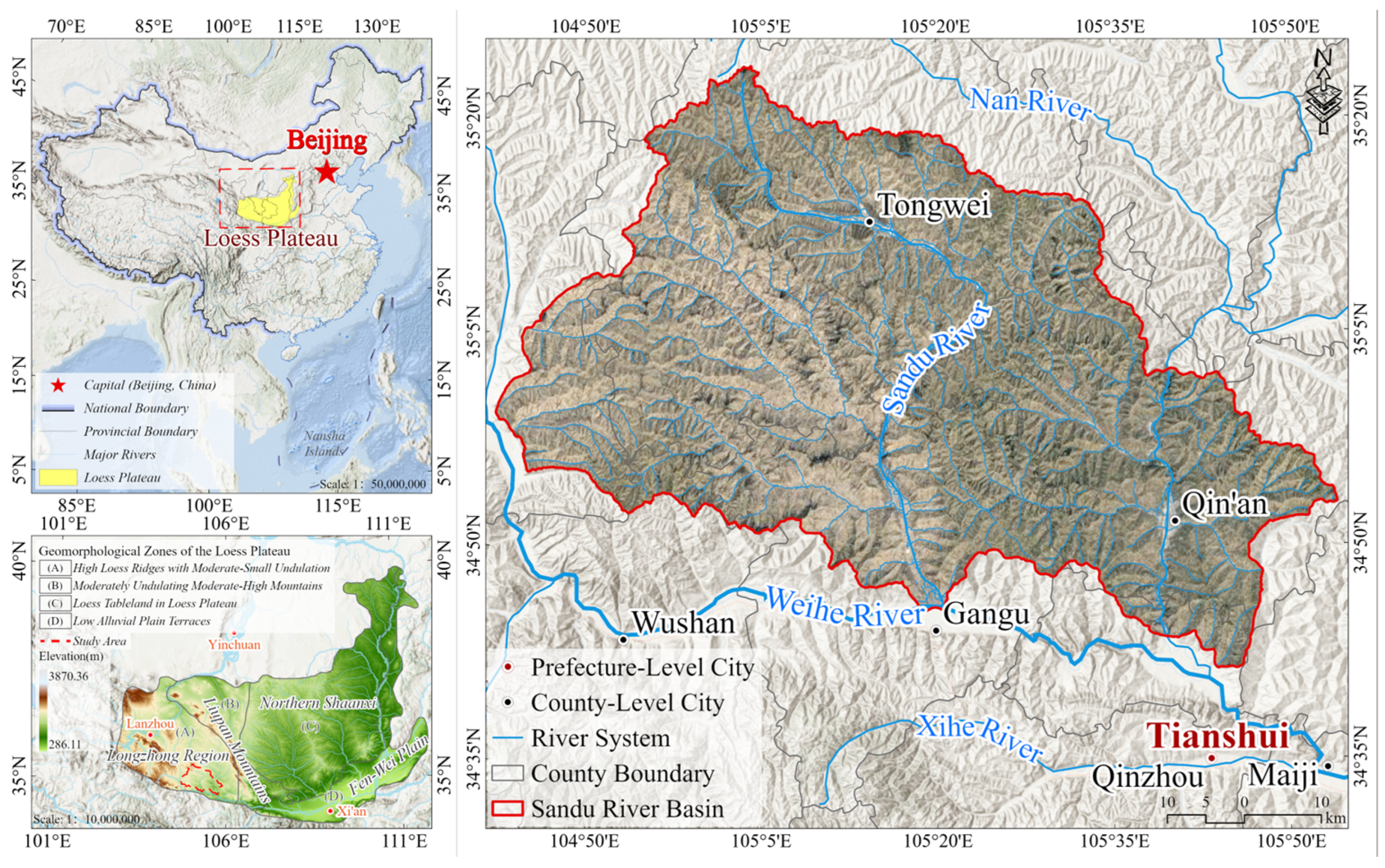

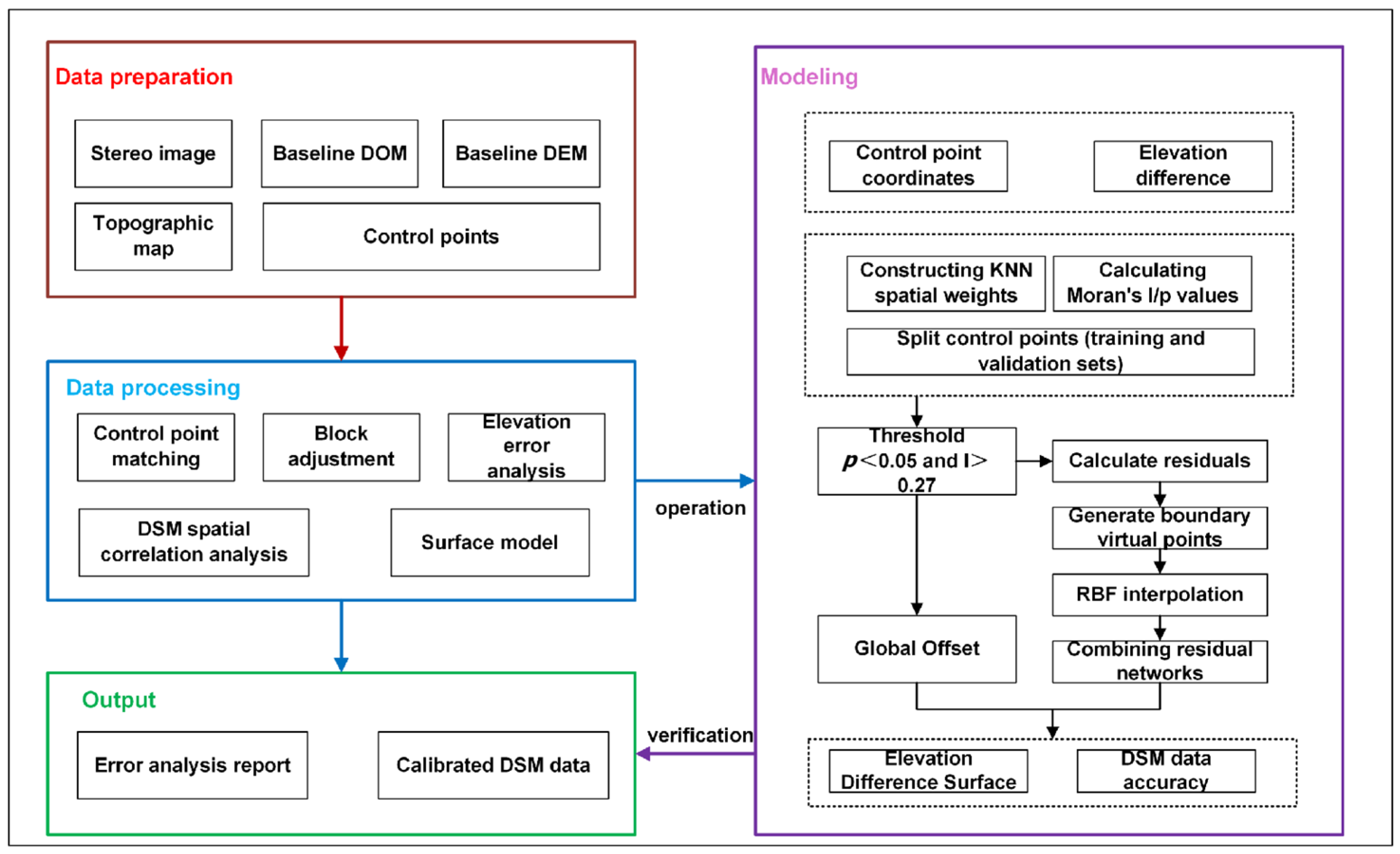
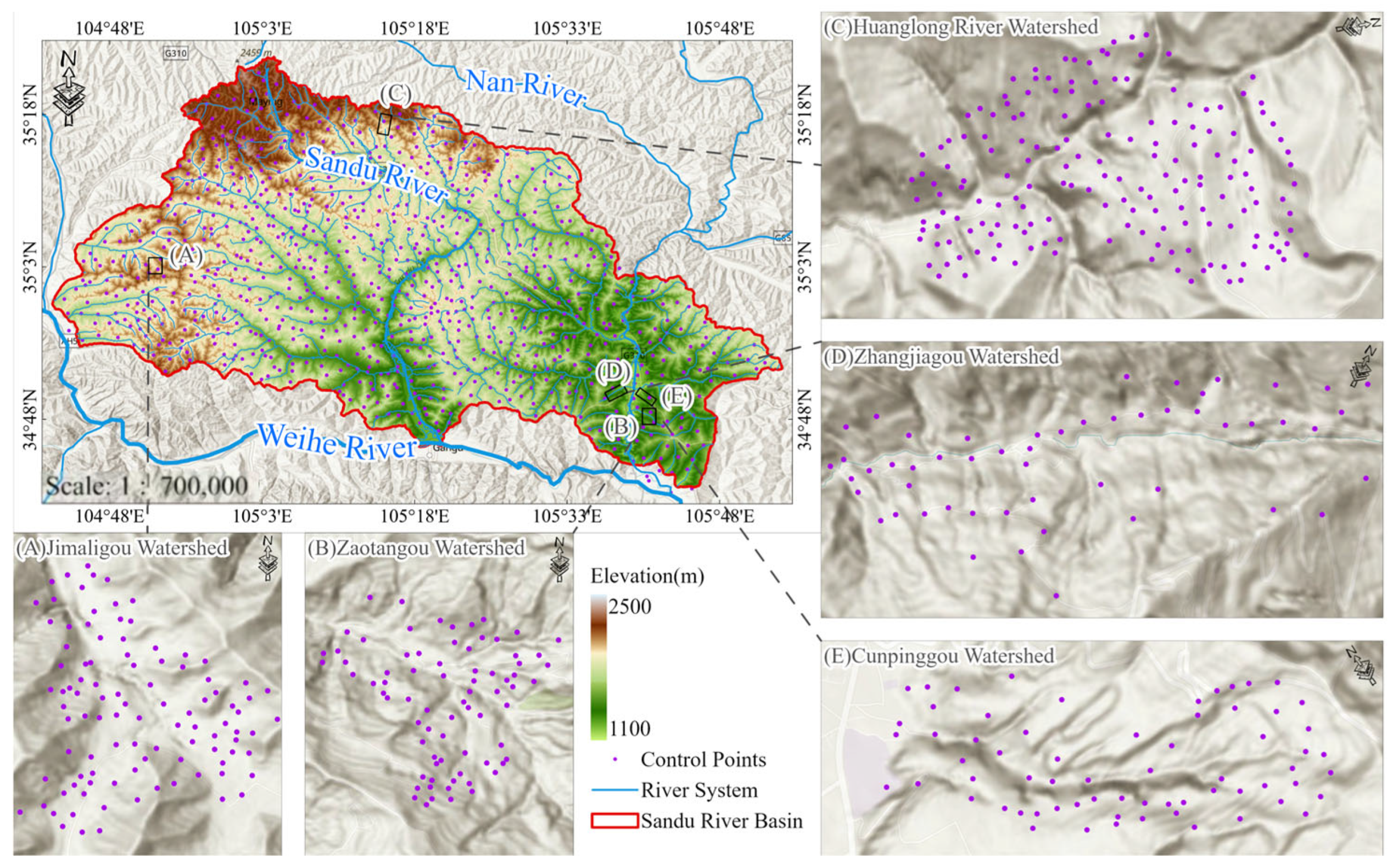

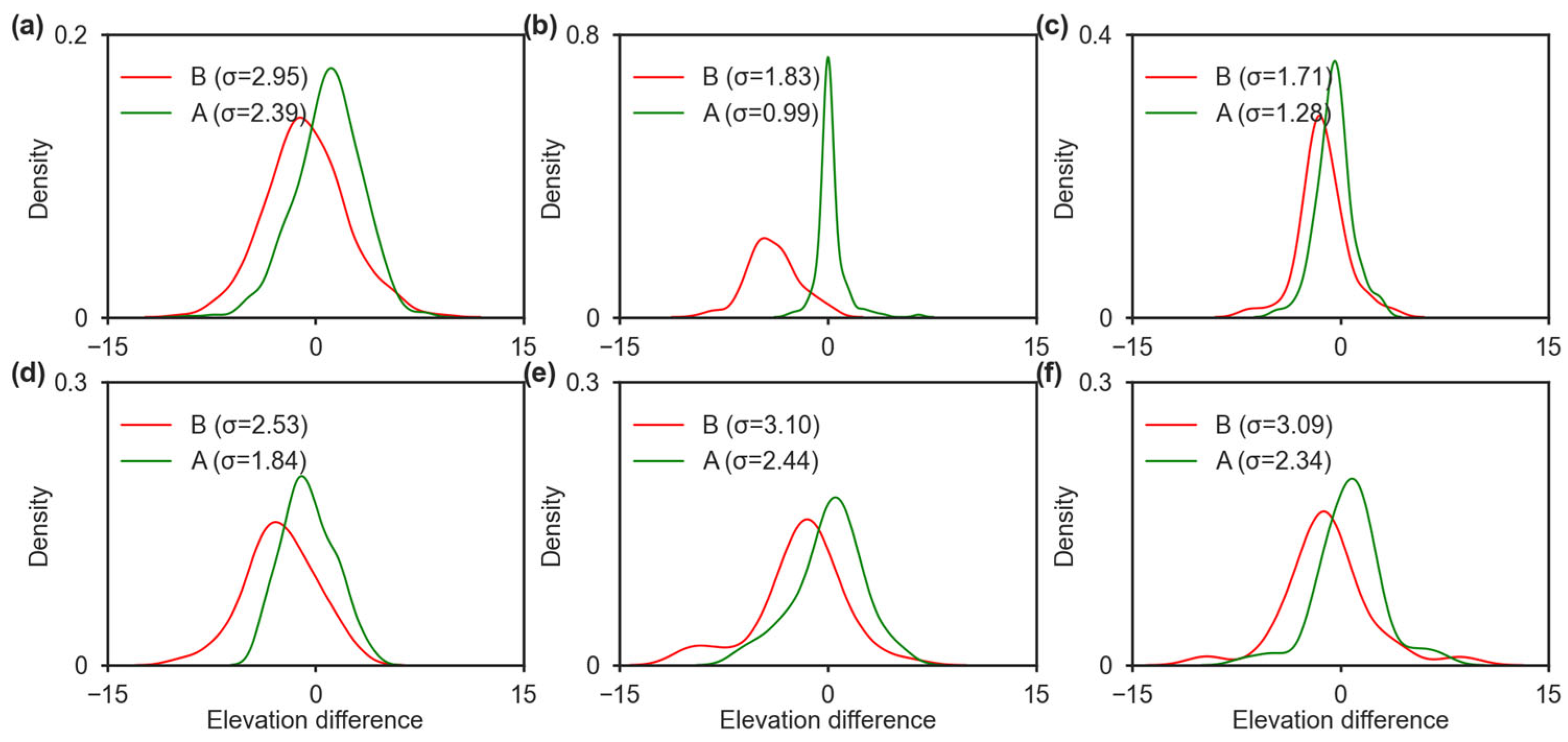
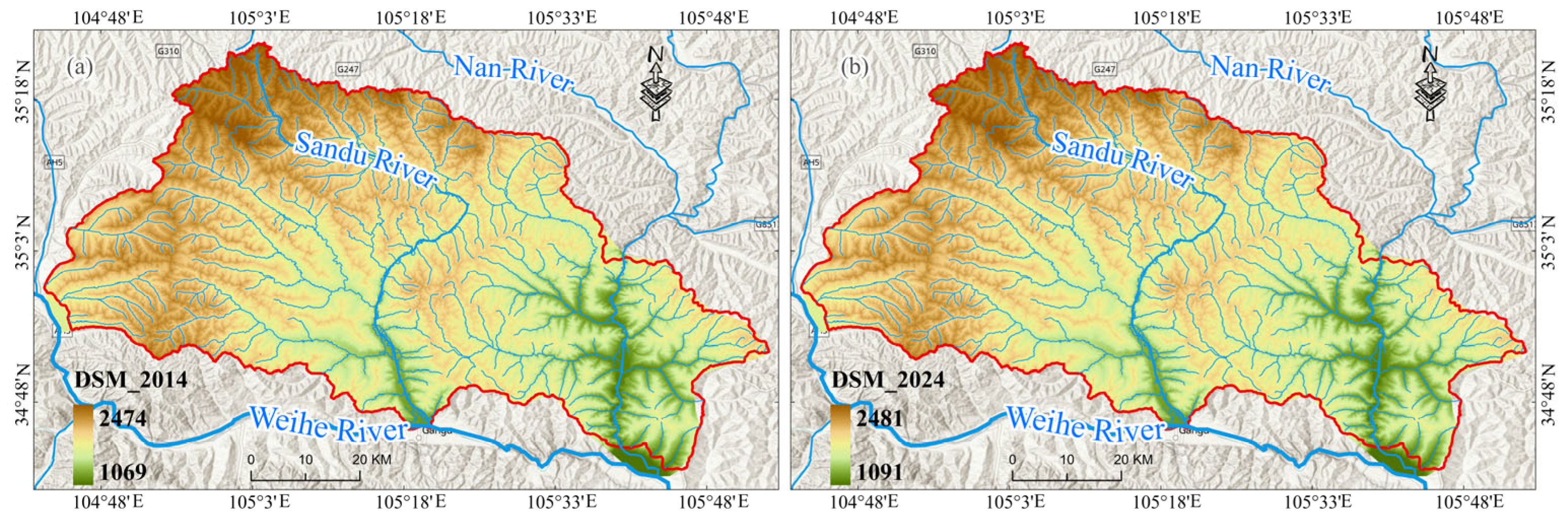

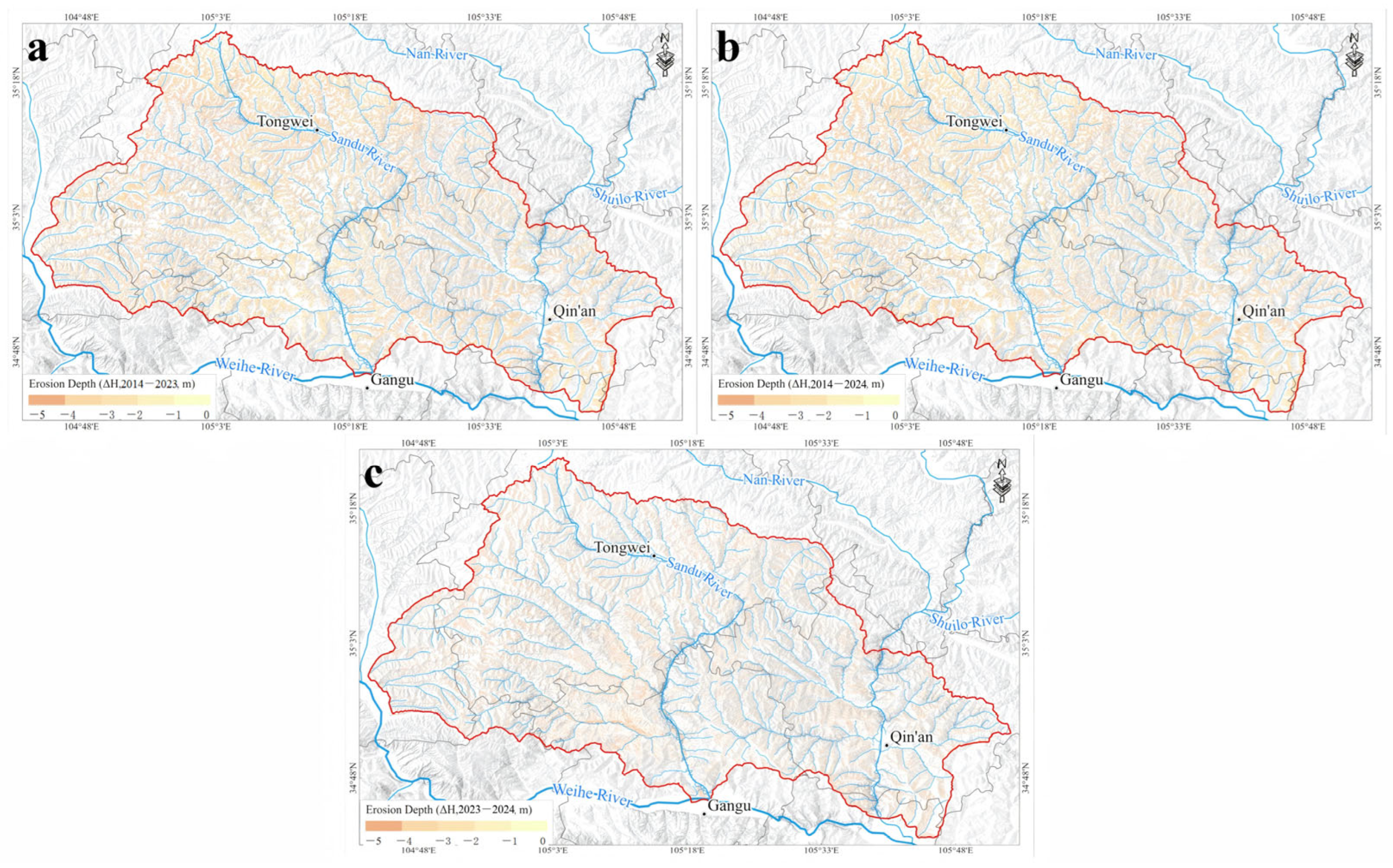

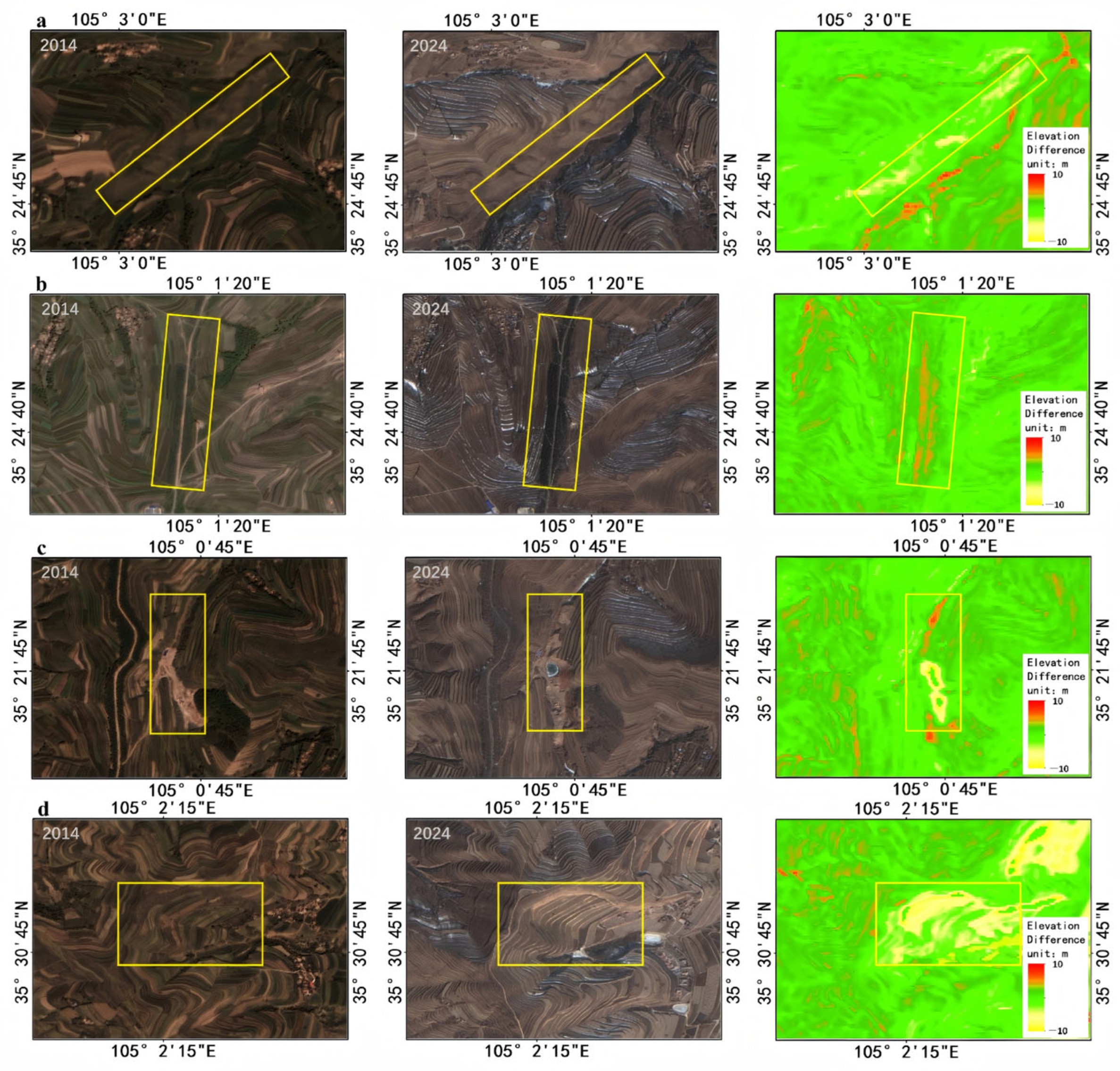
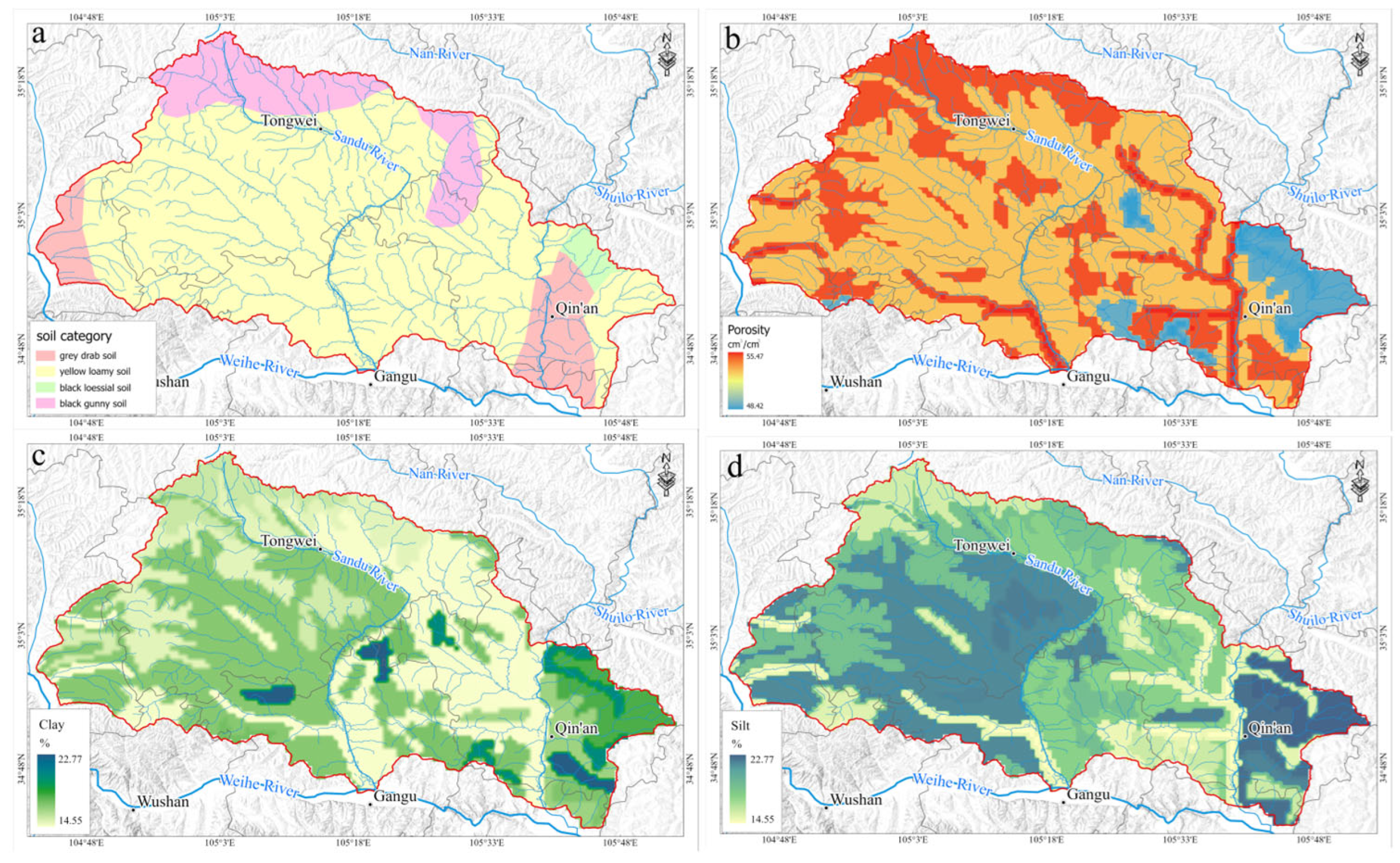
| Name | Resolution | Time | Bands | Sensor | Scenes | Data Preprocessing |
|---|---|---|---|---|---|---|
| CB04A | 2 m | 2024 | Blue, Green, Red, Nir | WPM | 1 | Geometric correction, orthorectification, and image fusion (the raw Level-1A data had already undergone radiometric calibration and atmospheric correction). |
| GF-1/GF1D | 2 m | 2014, 2015, 2019, 2024 | Blue, Green, Red, Nir | PMS1/PMS2/PMS | 22 | |
| GF-2 | 0.8 m | 2024 | Blue, Green, Red, Nir | PMS1/PMS2 | 2 | |
| ZY302A | 2 m | 2014, 2023, 2025 | Blue, Green, Red, Nir | PMS | 5 | |
| GF-6 | 2 m | 2019, 2024 | Blue, Green, Red, Nir | PMS | 3 | |
| ZY302A | 10 m | 2013–2017, 2019, 2020, 2022–2025 | Three-line-array data | TMS | 23 | Tie-/control-point matching, block (bundle) adjustment, spatial correlation analysis, and DSM-based correction |
| GF-7 | 0.8 m | 2020, 2023, 2024, 2025 | Blue, Green, Red, Nir | DLC | 12 | |
| UAV | 0.2m | 2024 | Blue, Green, Red, Nir; LiDAR | 5 | Import of flight-image metadata (overlap ratio and camera parameters), aerial triangulation/AT, ground control point selection, and data fusion | |
| Meteorological data | Daily | 2014–2024 | Station | 9 stations | Data correspondence, Kriging interpolation |
| Parameters Name | Final Parameters | Explanation |
|---|---|---|
| points_per_side | 128 | Defines sampling points along one image side. |
| pred_iou_thresh | 0.86 | Filters masks based on predicted quality, within the range [0, 1]. |
| stability_score_thresh | 0.92 | Adjusts cutoff for stability score calculation. |
| crop_n_layers | 1 | Determines the number of image crop layers, where each layer includes 2i image subdivisions. |
| crop_n_points_downscale_factor | 2 | Downscales sampled points per side for layer n by a factor of 2n. |
| min_mask_region_area | 80 | Removes small regions and holes in masks smaller than the specified area. |
| Classification Results | Erosion (%) | Non-Erosion (%) | User’s Accuracy (%) |
|---|---|---|---|
| Erosion (%) | 90.62 | 9.38 | 90.6 |
| Non-erosion (%) | 12.5 | 87.5 | 87.5 |
| Producer’s Accuracy | 0.8 | 0.91 | |
| Overall Accuracy: 0.89 | Kappa: 0.78 |
Disclaimer/Publisher’s Note: The statements, opinions and data contained in all publications are solely those of the individual author(s) and contributor(s) and not of MDPI and/or the editor(s). MDPI and/or the editor(s) disclaim responsibility for any injury to people or property resulting from any ideas, methods, instructions or products referred to in the content. |
© 2025 by the authors. Licensee MDPI, Basel, Switzerland. This article is an open access article distributed under the terms and conditions of the Creative Commons Attribution (CC BY) license (https://creativecommons.org/licenses/by/4.0/).
Share and Cite
Wang, L.; Qi, Y.; Xie, W.; Yang, R.; Wang, X.; Zhou, S.; Dong, Y.; Lian, X. Estimating Gully Erosion Induced by Heavy Rainfall Events Using Stereoscopic Imagery and UAV LiDAR. Remote Sens. 2025, 17, 3363. https://doi.org/10.3390/rs17193363
Wang L, Qi Y, Xie W, Yang R, Wang X, Zhou S, Dong Y, Lian X. Estimating Gully Erosion Induced by Heavy Rainfall Events Using Stereoscopic Imagery and UAV LiDAR. Remote Sensing. 2025; 17(19):3363. https://doi.org/10.3390/rs17193363
Chicago/Turabian StyleWang, Lu, Yuan Qi, Wenwei Xie, Rui Yang, Xijun Wang, Shengming Zhou, Yanqing Dong, and Xihong Lian. 2025. "Estimating Gully Erosion Induced by Heavy Rainfall Events Using Stereoscopic Imagery and UAV LiDAR" Remote Sensing 17, no. 19: 3363. https://doi.org/10.3390/rs17193363
APA StyleWang, L., Qi, Y., Xie, W., Yang, R., Wang, X., Zhou, S., Dong, Y., & Lian, X. (2025). Estimating Gully Erosion Induced by Heavy Rainfall Events Using Stereoscopic Imagery and UAV LiDAR. Remote Sensing, 17(19), 3363. https://doi.org/10.3390/rs17193363






